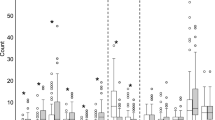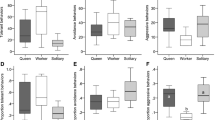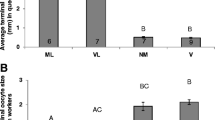Abstract
The establishment of dominance hierarchies through aggressive interactions is very common in insect societies. In many cases, it is also mediated through pheromone emissions that enable individuals to evaluate the reproductive quality and level of aggressiveness of the dominant individual, thereby reducing the number and intensity of costly fights. Here, we studied these processes in the primitively eusocial bee Bombus terrestris, using a paired bee system. Specifically, we investigated the behavioral, reproductive, and pheromonal correlates of dominance establishment. Workers were shown to establish dominance hierarchies using overt aggression within 3–4 days. Thereafter, the aggression drastically decreased, and dominance was maintained mostly by ritualized agonistic behavior. The behaviorally dominant bee lost the ester compounds that workers produce in their Dufour's gland (the so-called “sterility signal”) concomitantly with the development of her ovaries. The other bee announced as subordinate by continuously producing high amounts of those esters. The hypothesis that sterility signaling serves as an appeasement signal to pacify the dominant bees is supported by the negative correlation found between the proportion of these esters and the level of aggression that the subordinate received from the dominant worker. Physical interactions, and presumably also the ensuing overt aggression between the bees, were essential for the above pheromonal change to take place and enabled the dominant workers to develop their ovaries and to lay eggs. The subordinate bee’s signaling of non-reproductive status may minimize energy expenditure in costly fights and help stabilize the reproductive division of labor among workers.





Similar content being viewed by others
References
Alaux C, Jaisson P, Hefetz A (2004) Queen influence on worker reproduction in bumblebees (Bombus terrestris) colonies. Insect Soc 51:287–293
Alaux C, Jaisson P, Hefetz A (2006) Regulation of worker reproduction in bumblebees (Bombus terrestris): workers eavesdrop on a queen signal. Behav Ecol Sociobiol 60:439–446
Amsalem E, Twele R, Francke W, Hefetz A (2009) Reproductive competition in the bumblebee Bombus terrestris: do workers advertise sterility? Proc R Soc Lond B Biol Sci 276:1295–1304
Bhadra A, Iyer PL, Sumana A, Deshpande SA, Ghosh S, Gadagkar R (2007) How do workers of the primitively eusocial wasp Ropalidia marginata detect the presence of their queens? J Theor Biol 246:574–582
Bloch G, Hefetz A (1999) Regulation of reproduction by dominant workers in bumblebee (Bombus terrestris) queenright colonies. Behav Ecol Sociobiol 45:125–135
Bloch G, Borst DW, Huang ZY, Robinson GE, Hefetz A (1996) Effects of social conditions on juvenile hormone mediated reproductive development in Bombus terrestris workers. Physiol Entomol 21:257–267
Bourke AFG (1994) Worker matricide in social bee and wasps. J Theor Biol 167:283–292
Bourke AFG, Ratnieks FLW (2001) Kin-selected conflict in the bumblebee Bombus terrestris (Hymenoptera: Apidae). Proc R Soc Lond B Biol Sci 268:347–355
Cant MA, Llop JB, Field J (2006) Individual variation in social aggression and the probability of inheritance: theory and a field test. Am Nat 167:837–852
Cnaani J, Schmid-Hempel R, Schmidt JO (2002) Colony development, larval development and worker reproduction in Bombus impatiens cresson. Insect Soc 49:164–170
Cuvillier-Hot V, Gadagkar R, Peeters C, Cobb M (2002) Regulation of reproduction in a queenless ant: aggression, pheromones and reduction in conflict. Proc R Soc Lond B Biol Sci 269:1295–1300
Cuvillier-Hot V, Lenoir A, Crewe R, Malosse C, Peeters C (2004) Fertility signaling and reproductive skew in queenless ants. Anim Behav 68:1209–1219
Dronnet S, Simon X, Verhaeghe JC, Rasmont P, Errard C (2005) Bumblebee inquilinism in Bombus (fernaldaepsithyrus) sylvestris (Hymenoptera, Apidae): behavioral and chemical analyses of host–parasite interactions. Apidologie 36:59–70
Duchateau MJ (1989) Agonistic behaviors in colonies of the bumblebee Bombus terrestris. J Ethol 7:141–152
Endler A, Holldobler B, Liebig J (2007) Lack of physical policing and fertility cues in egg-laying workers of the ant Camponotus floridanus. Anim Behav 74:1171–1180
Free JB (1955) The division of labor within bumblebees colonies. Insect Soc 2:195–212
Gobin B, Billen J, Peeters C (1999) Policing behavior towards virgin egg layers in a polygynous ponerine ant. Anim Behav 58:1117–1122
Hamilton WD (1964) The genetical evolution of social behavior. I, II. J Theor Biol 7:1–52
Hammond RL, Keller L (2004) Conflict over male parentage in social insects. PLoS Biol 2:1472–1482
Innocent TM, West SA (2006) Social evolution: cooperation by conflict. Curr Biol 16:R365–R367
Ito F (1993) Functional monogyny and dominance hierarchy in the queenless ponerine ant Pachycondyla (equals Bothroponera) sp. in West Java, Indonesia (Hymenoptera, Formicidae, Ponerinae). Ethology 95:126–140
Keller L, Nonacs P (1993) The role of queen pheromones in social insects: queen control or queen signal? Anim Behav 45:787–794
Kikuta N, Tsuji K (1999) Queen and worker policing in the monogynous and monandrous ant, Diacamma sp. Behav Ecol Sociobiol 46:180–189
Kravitz EA, Huber R (2003) Aggression in invertebrates. Curr Opin Neurobiol 13:736–743
Lamba S, Kazi YC, Deshpande S, Natesh M, Bhadra A, Gadagkar R (2007) A possible novel function of dominance behavior in queen-less colonies of the primitively eusocial wasp Ropalidia marginata. Behav Process 74:351–356
Le Conte Y, Hefetz A (2008) Primer pheromones in social hymenoptera. Annu Rev Entomol 53:523–542
Liebig J, Peeters C, Holldobler B (1999) Worker policing limits the number of reproductives in a ponerine ant. Proc R Soc Lond B Biol Sci 266:1865–1870
Lopez-Vaamonde C, Koning JW, Brown RM, Jordan WC, Bourke AFG (2004) Social parasitism by male-producing reproductive workers in a eusocial insect. Nature 430:557–560
Malka O, Snior S, Katzav-Gozansky T, Hefetz A (2008) Aggressive reproductive-competition among hopelessly queenless honeybee workers triggered by pheromone signaling. Naturwissenschaften 95:553–559
Molina Y, O'Donnell S (2009) Worker reproductive competition affects division of labor in a primitively social paperwasp (Polistes instabilis). Insect Soc 56:14–20
Monnin T, Peeters C (1999) Dominance hierarchy and reproductive conflicts among subordinates in a monogynous queenless ant. Behav Ecol 10:323–332
Moritz RFA, Simon UE, Crewe RM (2000) Pheromonal contest between honeybee workers (Apis mellifera capensis). Naturwissenschaften 87:395–397
Oliveira PS, Hoelldobler B (1990) Dominance orders in the ponerine ant Pachycondyla apicalis (Hymenoptera, Formicidae). Behav Ecol Sociobiol 27:385–394
Plettner E, Slessor KN, Winston ML, Robinson GE, Page RE (1993) Mandibular gland components and ovarian development as measures of caste differentiation in the honeybee (Apis mellifera L.). J Insect Physiol 39:235–240
Premnath S, Sionha A, Gadagkar R (1996) Dominance relationship in the establishment of reproductive division of labor in a primitively eusocial wasp (Ropalidia marginata). Behav Ecol Sociobiol 39:125–132
Reeve HK (1991) Polistes. The social biology of wasps, Cornell University, Ithaca, New York
Roseler PF (1977) Juvenile hormone control of oogenesis in bumblebee workers, Bombus terrestris. J Insect Physiol 23:985–992
Roseler PF, van-Honk CGJ (1990) Cast and reproduction in bumblebees. In: Engels W (ed) Social insects: an evolutionary approach to castes and reproduction. Springer Verlag, Berlin, pp 147–166
Roseler PF, Roseler I, van Honk CGJ (1981) Evidence for inhibition of corpora allata in workers of Bombus terrestris by a pheromone from the queen’s mandibular gland. Experientia 37:348–351
Solomon NG, French JA (1997) Cooperative breeding in mammals. Cambridge University Press, Cambridge
Stacey PB, Koenig WD (1990) Cooperative breeding in birds. Long term studies of ecology and behavior. Cambridge University Press, Cambridge
Sumana A, Gadagkar R (2003) Ropalidia marginata—a primitively eusocial wasp society headed by behaviorally non-dominant queens. Curr Sci 84:1464–1468
van Doorn A (1989) Factors influencing dominance behavior in queenless bumblebee workers Bombus terrestris. Physiol Entomol 14:211–222
van Doorn A, Heringa J (1986) The ontogeny of a dominance hierarchy in colonies of the bumblebee Bombus terrestris (Hymenoptera, Apidae). Insect Soc 33:3–25
van Honk CGJ, Hogeweg P (1981) The ontogeny of the social structure in a captive Bombus terrestris colony. Behav Ecol Sociobiol 9:111–119
van Honk CGJ, Velthuis HHW, Roseler PF, Malotaux ME (1980) The mandibular glands of Bombus terrestris queens as a source of queen pheromone. Entomol Exp Appl 28:191–198
van Honk CJK, Roeseler PF, Velthuis HHW, Hogeveen JC (1981) Factors influencing egg laying of workers in a captive Bombus terrestris colony. Behav Ecol Sociobiol 9:9–14
Vargo EL, Passera L (1991) Pheromonal and behavioral queen control over the production of gynes in the Argentine ant Iridomyrmex humilis (Mayr). Behav Ecol Sociobiol 28:161–170
Acknowledgment
This research was supported by a grant from The Israel Science Foundation founded by the Israel Academy of Sciences (ISF grant no. 535/08). We thank Naomi Paz for editorial assistance.
Conflict of interest
The authors declare that they have no conflict of interest.
Author information
Authors and Affiliations
Corresponding author
Additional information
Communicated by O. Rueppell
Rights and permissions
About this article
Cite this article
Amsalem, E., Hefetz, A. The appeasement effect of sterility signaling in dominance contests among Bombus terrestris workers. Behav Ecol Sociobiol 64, 1685–1694 (2010). https://doi.org/10.1007/s00265-010-0982-4
Received:
Revised:
Accepted:
Published:
Issue Date:
DOI: https://doi.org/10.1007/s00265-010-0982-4




